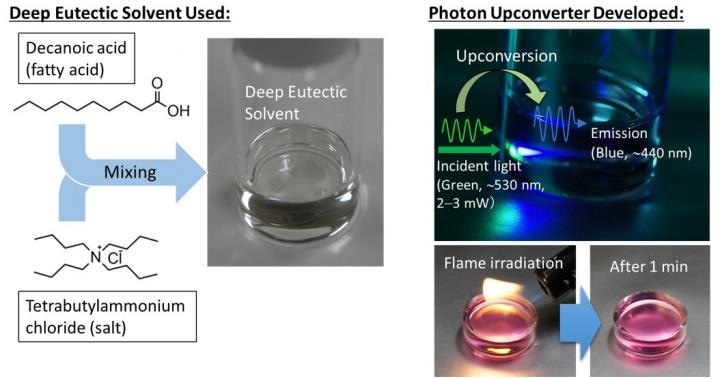Dec 4 2017
A concept called the Shockley-Quesser limit currently restricts the conversion of solar energy into electricity. This restriction causes lower energy photons to be wasted, while enabling those that possess higher energies than those of the bandgap to be utilized.
In order to find a solution to this problem and also make the conversion of solar energy more efficient, a process called photon upconversion was developed. This process converts lower energy photons into higher energy ones.
 Deep eutectic solvents used as the medium of sensitizer and emitter chromophores (left) and the photon upconverter developed (right). The sample converts low-intensity (a few mW) green light into clear blue emission and demonstrates high thermal stability during exposure to a burner flame for 1 min. (Credit: Yoichi Murakami)
Deep eutectic solvents used as the medium of sensitizer and emitter chromophores (left) and the photon upconverter developed (right). The sample converts low-intensity (a few mW) green light into clear blue emission and demonstrates high thermal stability during exposure to a burner flame for 1 min. (Credit: Yoichi Murakami)
In the past 10 years, a photon upconversion method that employs triplet-triplet annihilation (TTA) of organic molecules has attracted a great deal of attention because it is currently the only method that can be applied to weak light, for example sunlight. Photon upconversion involves combining two kinds of organic chromophores or molecules – an emitter and a sensitizer. The sensitizer can absorb a photon and change it to its excited triplet state. The resultant excitation energy is subsequently transferred to the emitter. When two emitters containing the excitation energy collide, one releases an upconverted photon after converting to its lowest excited singlet state. This photon can be harvested for converting energy.
A number of studies on photon upconversion have been performed in organic solvents, but their practical application is rather limited because of their high flammability, vapor toxicity, vapor pressures, and absence of thermal stability of the solvent mixtures. To date, many methods have been proposed to resolve these restrictions, including the utilization of viscous fluidic media like ionic liquids that are characterized by high thermal stability and low vapor pressures. However, ionic liquids are also restricted in practicality because of the relatively high costs of synthetic processes and starting materials, in addition to their poor biodegradability.
In order to overcome these earlier problems, researchers at Tokyo Institute of Technology developed a TTA photon upconversion using deep eutectic solvents (DESs) – a new class of liquids. DESs provide a promising alternative to ionic fluids, as they have desirable properties analogous to those of ionic fluids and can be produced through a simple combination of two substances – a hydrogen bond acceptor and hydrogen bond donor – without any need for synthetic processes. In addition, the initial substances for the creation of DESs are also relatively safer, cheaper, and more biodegradable than those required for the generation of ionic liquids, thus making them a suitable alternative.
The images of photon upconverters developed and the DESs used are shown below. The prepared DES was colorless and optically transparent (left of Figure 1) and utilized as the solvent for the emitter and sensitizer chromophores. The images of the photon upconverter developed are illustrated in the right of Figure 1.
Weak incident green light (wavelength: 532 nm; power: 2-3 mW) are converted into blue emission (wavelength: ~440 nm) by the sample. The absence of ignition and fuming confirmed the predicted high thermal stability during exposure to a burner flame for 1 minute.
It was observed that the photon upconversion quantum yield of the samples achieved 0.21 (where the maximum quantum yield is defined as 0.5; by using two lower-energy photons at maximum in photon upconversion, one higher-energy photon is produced). This relates to the upconversion quantum efficiency of 42% (whose maximum is defined as 100%), and is known to be a relatively high efficiency.
On the whole, the researchers used cheaper, thermally stable, and less toxic DESs to develop an innovative material platform for TTA photon upconversion. This achievement is believed to be a key milestone toward the realization of practical use of photon upconversion technology.